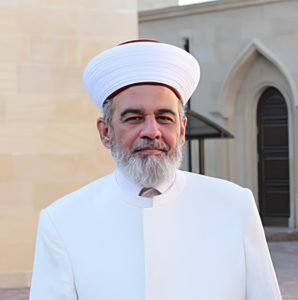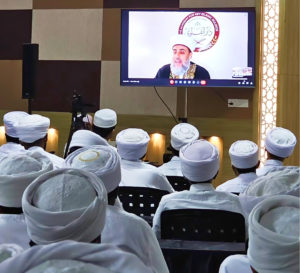In the month of Ramadan, it is recommended every night to perform an optional prayer after the ^Isha’ prayer. It is called the Qiyam of Ramadan prayer. Some also call it the Tarawih prayer. The Messenger of Allah ﷺ said:
صلاةُ الليلِ مَثْنى مَثنى ، فإذا خَشِيَ أحدُكُم الصُّبحَ فلْيُوتِرْ بِرَكعة} رواه البخاري ومسلم}
which means: ‘’The prayer at night is (preferrably) two rak^ahs at a time. If one fears the dawn will break, let one pray one rak^ah of witr.” (Narrated by al-Bukhariyy, Muslim) The Messenger of Allah ﷺ also said:
{أُوتِروا بخمسٍ أو بسبْعٍ أو بتسْعٍ أو بإحدى عشْرة أو بأكثَرَ مِنْ ذلك}
which means: “Pray the witr after praying five, seven, nine, eleven, or more.” (Narrated by Ibn Hibban, Ibnul-Mundhir, al-Hakim)
These two hadiths signify that the Muslim may pray after ^Isha’ as many rak^ahs as desired, without specifying a maximum number. Lady A’ishah may Allah raise her rank said:
{ما زادَ رسولُ الله صلى الله عليه وسلَم في صلاة الليلِ في رمضانَ ولا في غيرِهِ على إحْدى عشْرةَ ركْعة}
Which means: “The Messenger of Allah did not pray at night more than eleven rak^ahs in Ramadan or otherwise.” (Narrated by al-Bukhariyy) This hadith only tells what Lady A’ishah witnessed the Prophet do. It does not mean that one cannot pray more than eleven rak^ahs. This is substantiated by the hadith of Imam ^Aliyy narrated by Hafidh al-Khila^iyy that the Prophet sallallahu alayhi wa sallam prayed sixteen rak^ahs at night. Hafidh al-^Iraqiyy said that its chain is good.
It became conventional among many to label the twenty rak^ahs followed by the three witr rak^ahs the Tarawih prayer. As for the Qiyam of Ramadan, Imam ash-Shafi^iyy said: ‘’There is no limit for the number of rak^ahs the Qiyam of Ramadan prayer has.” Hence, let the intention in the heart be: “I now pray the Qiyam of Ramadan prayer”. It is also good to pray it in congregation. The practice in the Islamic countries is to recite the thirty Juz’s of the Qur’an in the congregational Qiyam of Ramadan prayer, at the rate of one Juz‘ every night.





